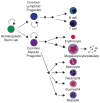A System to Study Aneuploidy In Vivo
- PMID: 26936868
- PMCID: PMC5082706
- DOI: 10.1101/sqb.2015.80.027193
A System to Study Aneuploidy In Vivo
Abstract
Aneuploidy, an imbalanced chromosome number, is associated with both cancer and developmental disorders such as Down syndrome (DS). To determine how aneuploidy affects cellular and organismal physiology, we have developed a system to evaluate aneuploid cell fitness in vivo. By transplanting hematopoietic stem cells (HSCs) into recipient mice after ablation of recipient hematopoiesis by lethal irradiation, we can directly compare the fitness of HSCs derived from a range of aneuploid mouse models with that of euploid HSCs. This experimental system can also be adapted to assess the interplay between aneuploidy and tumorigenesis. We hope that further characterization of aneuploid cells in vivo will provide insight both into the origins of hematopoietic phenotypes observed in DS individuals as well as the role of different types of aneuploid cells in the genesis of cancers of the blood.
Copyright © 2015 Cold Spring Harbor Laboratory Press; all rights reserved.
Figures





References
-
- Alford KA, Reinhardt K, Garnett C, Norton A, Böhmer K, Neuhoff von C, Kolenova A, Marchi E, Klusmann J-H, Roberts I, et al. Analysis of GATA1 mutations in Down syndrome transient myeloproliferative disorder and myeloid leukemia. Blood. 2011;118:2222–2238. - PubMed
-
- Baker DJ, Jeganathan KB, Cameron JD, Thompson M, Juneja S, Kopecka A, Kumar R, Jenkins RB, de Groen PC, Roche P, et al. BubR1 insufficiency causes early onset of aging-associated phenotypes and infertility in mice. Nature Genetics. 2004;36:744–749. - PubMed
Publication types
MeSH terms
Grants and funding
LinkOut - more resources
Full Text Sources
Other Literature Sources
Medical
